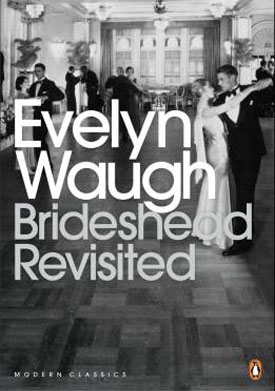[The above video is mostly a
reading of the text below, with an occasional aside thrown in for good measure
as they strike me as relevant. I welcome questions, comments, or concerns about the material contained in
this video.]
For some reason, my choice in books has been leading me to those with obvious themes of decadence, decay, and destruction. In the past few weeks alone, I’ve read or finished Philip Rieff’s “Charisma: The Gift of Grace, and How It Has Been Taken Away From Us,” (Rieff manages to make Oswald Spengler look like Pippy Longstocking) Cormac McCarthy’s “Blood Meridian,” and now “Brideshead Revisited.” This wasn’t exactly planned out, but reading them so close together has been a wonderful experience, and not nearly as disheartening as one might think it would be.
Picking up “Brideshead Revisited,” I had the odd feeling that it would end up being much like “Lucky Jim.” It would have its moments, but in the end it would be too peculiar to English mores and ways of life to translate very well for the American reader of the twenty-first century. My initial impression couldn’t have been more wrong. It is full of a beautiful pathos, a reverence and passion for those things that have been irrevocably lost, and contains a poignant portrait of a youthful relationship that will stick with me for a while.
The entire thing is a flashback; only in the prologue do we learn that the narrator, Charles Ryder, is actually remembering the novel retroactively twenty years in the future while serving as an officer in World War II. Like Proust’s, his memories are set off by a particular sensory experience, namely his bivouacking at Brideshead, the palatial residence of his best friend he met at Oxford, Sebastian Flyte. Sebastian comes from an incredibly wealthy family, and carries a teddy bear named Aloysius everywhere he goes. (It’s also pretty explicitly stated that Sebastian is a homosexual, and doesn’t bother hiding it.) He and Charles become fast friends on campus, often getting drunk together. Sebastian suggests that Charles meet his family, and he slowly develops relationships with Sebastian’s mother and siblings. Much of the novel contains beautiful descriptions of Brideshead and its invaluable art and architecture; Waugh even calls the first part of the book “Et in Arcadia Ego.” When Charles starts to develop friendships with his family members, his drinking quickly spirals out of control, and he starts to exhibit the typical symptoms of denial and drinking in private.
While Charles and Sebastian are agnostics, Sebastian’s family is immured in cultural Catholicism, which complicates his relationship within the family, especially Julia, Sebastian’s sister. There is even a beautiful art nouveau chapel on the estate which Julia and her mother visit often. This combined with Sebastian’s drinking leads to Charles’ estrangement from the family. Julia and Charles eventually enter into loveless marriages, but eventually plan to divorce their mutual spouses to marry one another. However, when the family patriarch, Lord Marchmain, comes back home from Italy to Brideshead to live his last days, there is tension between Julia and Charles about giving Lord Marchmain his last rites. Because of this, Julia decides that their marriage will be impossible. The epilogue returns to Ryder’s unexpected billet at Brideshead, where the prologue began, and where we learn that he’s lead a life as an architectural historian and draughtsman.
I thought this novel was stunning. Waugh paints a picture of England in the interwar years that is full of nostalgia, but is never maudlin or saccharine. It’s about loss – the loss of friendship, the loss of Catholic religion and traditional values, the loss of youth, and the loss of innocence. These are great themes, and Waugh treats them spectacularly. For some great insight into the feelings and intellectual currents that informs the characters, I highly recommend Richard Overy’s “The Twilight Years: The Paradox of Britain Between the Wars,” which topically discusses some of the cultural themes that informs much of the book.

No comments:
Post a Comment